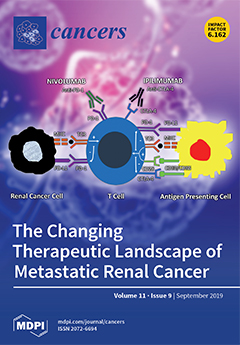BRAF V600 mutations have been found in 1–2% of non-small-cell lung cancer (NSCLC) patients, with Food and Drug Administration (FDA) approved treatment of dabrafenib plus trametinib and progression free survival (PFS) of 10.9 months. However, 50–80% of
BRAF mutations in lung cancer are
[...] Read more.
BRAF V600 mutations have been found in 1–2% of non-small-cell lung cancer (NSCLC) patients, with Food and Drug Administration (FDA) approved treatment of dabrafenib plus trametinib and progression free survival (PFS) of 10.9 months. However, 50–80% of
BRAF mutations in lung cancer are non-V600, and can be class II, with intermediate to high kinase activity and RAS independence, or class III, with impaired kinase activity, upstream signaling dependence, and consequently, sensitivity to receptor tyrosine kinase (RTK) inhibitors. Plasma cell-free DNA (cfDNA) of 185 newly diagnosed advanced lung adenocarcinoma patients (Spanish Lung Liquid versus Invasive Biopsy Program, SLLIP, NCT03248089) was examined for
BRAF and other alterations with a targeted cfDNA next-generation sequencing (NGS) assay (Guardant360®, Guardant Health Inc., CA, USA), and results were correlated with patient outcome. Cell viability with single or combined RAF, MEK, and SHP2 inhibitors was assessed in cell lines with
BRAF class I, II, and III mutations. Out of 185 patients, 22 had
BRAF alterations (12%) of which seven patients harbored amplifications (32%) and 17 had
BRAF mutations (77%). Of the
BRAF mutations, four out of 22 (18%) were V600E and 18/22 (82%) were non-V600. In vitro results confirmed sensitivity of class III and resistance of class I and II
BRAF mutations, and BRAF wild type cells to SHP2 inhibition. Concomitant MEK or RAF and SHP2 inhibition showed synergistic effects, especially in the class III
BRAF-mutant cell line. Our study indicates that the class of the
BRAF mutation may have clinical implications and therefore should be defined in the clinical practice and used to guide therapeutic decisions.
Full article






